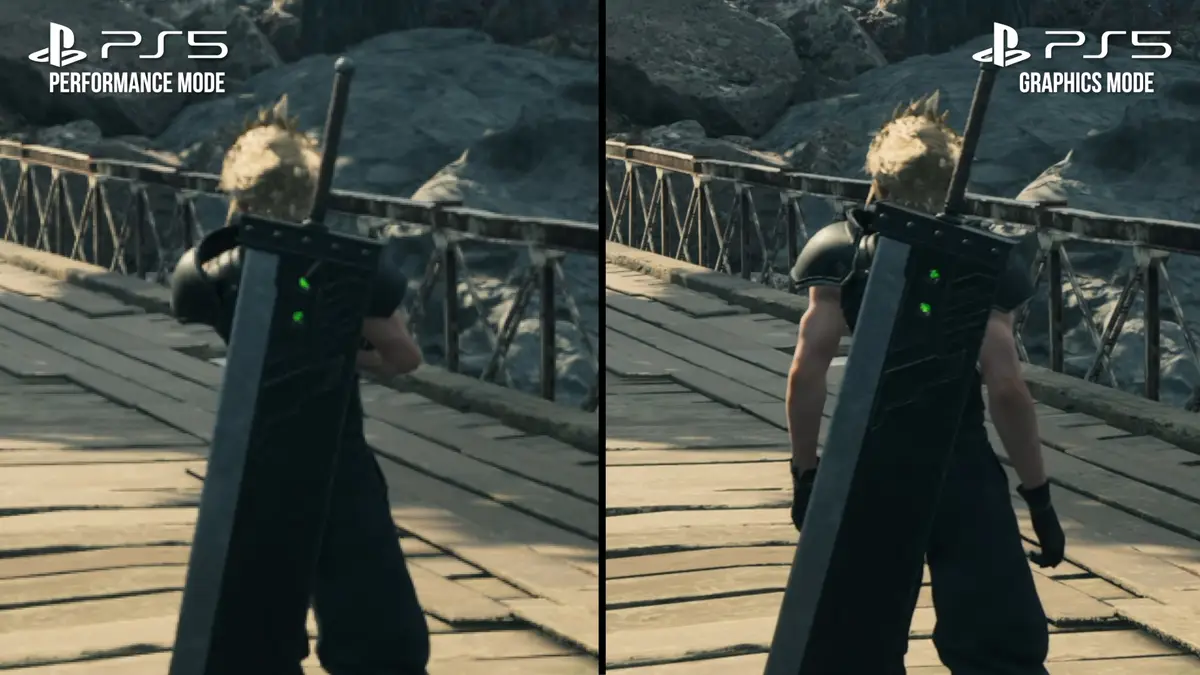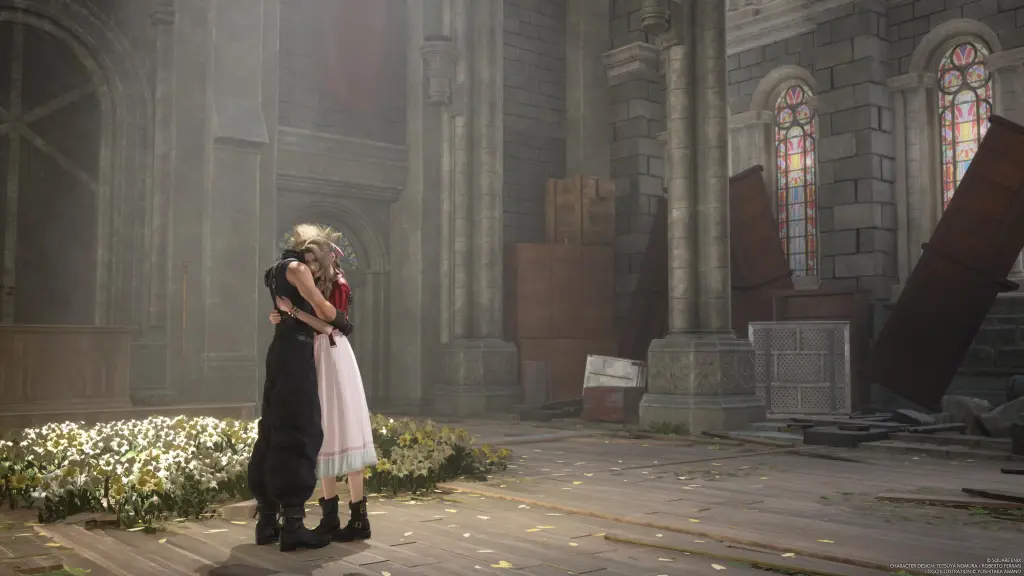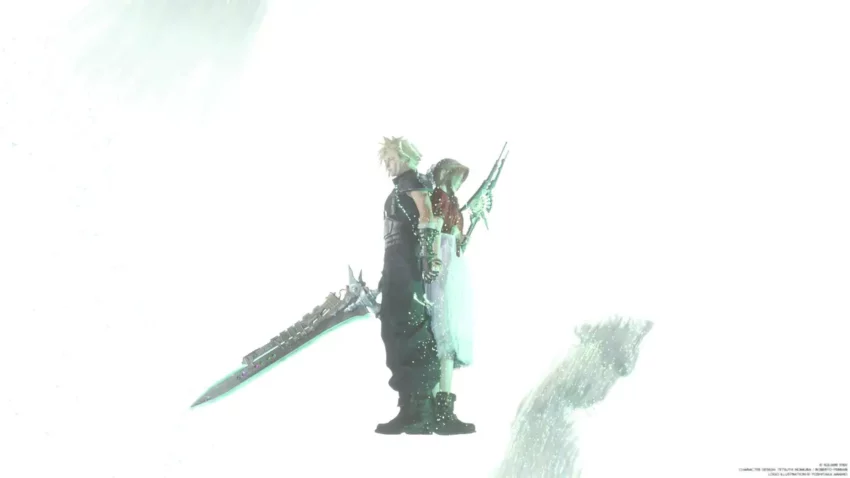Artistically Brilliant but Technically Behind the Times?

Final Fantasy VII has always been a winner in terms of artistry, both visually and aurally. Its artistic design remains unparalleled, a fact that was true in 1997 when the original game was released and still holds today. Back then, Square Enix (then Squaresoft) was at the cutting edge of technology.
While Final Fantasy VII was not a technical masterpiece in the same vein as 3D-rendering milestones like Super Mario 64 or GoldenEye 007, it excelled as a “visual illusion” that pushed the boundaries of what was possible on the PlayStation 1. The game heavily relied on pre-rendered backgrounds and CG cutscenes, which were not processed by the PS1 hardware but by high-end Silicon Graphics workstations. Through clever marketing and the use of these pre-rendered assets combined with polygonal characters, Final Fantasy VII created a visual spectacle that was unlike anything else at the time. This approach would go on to influence many other RPGs, and even games in other genres, in the years that followed.
Though Square wasn’t pioneering real-time 3D graphics at the time (as far as real time gameplay went), it was, without a doubt, leading the charge in terms of visual innovation on the PlayStation 1. In 1997, Final Fantasy VII was as good as it got for console gaming.
Fast forward to 2024, and the situation has changed. While Square Enix remains a significant player in the industry and continues to be a leader in cinematic, pre-rendered cutscenes, its approach to full 3D worlds is much less than groundbreaking. The company now relies on the Unreal Engine 4 to render large-scale, fully 3D environments—though these worlds are not entirely open, and the results are mixed in terms of their technical success. While Square Enix remains an artistic force, its approach to world-building in 2024 does not have quite the same visual impact as it did in the past.
In terms of faithfully representing the towns and world of Final Fantasy VII (1997), Rebirth succeeds admirably. However, when it comes to evoking the same sense of awe that the original did nearly three decades ago, Square’s latest offering falls short. Take any other open-world action RPG or adventure game—Red Dead Redemption 2, Horizon Forbidden West, or Ghost of Tsushima, for instance. All of these titles surpass Rebirth in visual fidelity, and their worlds feel far more dynamic and interactive.
This holds true even though these other games were developed for the previous generation of consoles, whereas Rebirth is a PS5 exclusive (despite likely having been conceived in PS4 hardware). While the game does a remarkable job of recreating the original’s pre-rendered backgrounds in full 3D, it doesn’t set new standards for the genre or manage to leave the kind of lasting impression that players like myself, who are deeply passionate about immersive/dynamic worlds, might hope for. Rebirth delivers on nostalgia, but in terms of pushing boundaries, it ultimately falls short.
Where Final Fantasy VII: Rebirth Struggles
Final Fantasy: Rebirth Further’s Cements its Status as Sequel Rather Than a “Remake” of the Original Game – The Multiverse Lives!

It is inconceivable that any fan of the original Final Fantasy VII could have completed FFVII: Remake without recognizing that they had been duped by Square Enix’s marketing strategy. Instead of being a straightforward remake, FFVII: Remake serves as a genuine sequel, set in an alternate timeline, defying the expectations of a faithful recreation of the original game.
The project has expanded on some of the game’s most iconic scenes within a new context and time frame. Notably, Rebirth introduces at least two distinct universes and timelines running in parallel which sometimes intersect, effectively positioning the original game within its own separate universe and timeline. The changes between the original’s storyline, and FFVII Rebirth are vast.
By this logic, is likely that there are a number of infinite universes and possibilities within the Final Fantasy VII storyline. There are just too many events, characters (such as Roach), and 0rder of said events that do not match with the original game for me to say that this is Final Fantasy VII’s story told with modern graphics and writing. It isn’t, Rebirth further deviates from the original game into its own thing…and that’s not necessarily a bad thing.
A lot of the nonsensical shenanigans present in the sequel would likely be more jarring if the game adhered to the darker, more realistic tone of its original timeline. Square Enix made a thoughtful decision in crafting a sequel that offers a fresh narrative direction, providing a new experience for long-time fans who have played through the original multiple times over the past 28 years.
I don’t know how this story will end, but Zack lives in a different timeline, and Aerith dies (like she always did) in the original timeline. But given the nature of the multiverse, there is a possibility she does live in many timelines as well. In fact, Rebirth hints at both her death and her survival at the end of the game… Yes, it makes no sense within the confines of the the dark, gritty and realistic original masterpiece, but in the multiverse…anything goes!
I still strongly feel that the original game (which remains the best game in the entire saga) is the true canon, as Sakaguchi intended. Everything else after that, from the compilation to the “Remake” project, is purely ‘fan fiction’ service. In this multiverse, Aerith and Cloud can finally live happily ever after! Or maybe, Cloud and Tifa! Or Maybe, Zack and Aerith finally get their love story to end happily together. Or maybe, they all die with Sephiroth winning, or Maybe Zack falls for Elmyra!
The concept of the multiverse suggests that every possible “What if?” scenario could indeed be realized, making virtually anything conceivable a potential reality. This was Nomura’s goal with the remake project. To please everyone, and perhaps, no one, all at once. The most damning thing is that some characters such as Aerith and Sephirtoth have knowledge of previous and parallel universes/timelines. By the end of Rebirth, Cloud joins the list in those characters who have not only witness the existence of the multiverse, but have somehow themselves travelled through the timelines and universes.
Still, I must admit that it is an enticing prospect to see how some scenarios could play out given the different choices that our characters can make. For that, I give Square Enix some credit. Even if Nojima and Nomura do turn FFVII’s storyline in the Kingdom Hearts lite.
Why the Original Game Remains the Better Work
For starters, it is a complete storyline. More importantly, unlike the multiverse shenanigans…the original 1997 game made complete sense. The game was gritty, and it wouldn’t be until its later stages where Cloud and Sephiroth would display ‘god’ like powers. Cid was an unhappy son of a gun who treated his wife/partner like crap. His professionally failures, and failed dreams turned him into a dark person. Zack died an unceremonious death in a muddy (or dusty) gutter. He was shot by two grunts and an officer. Yes, you can be a Delta operator, but an idiot with a gun can kill you all the same. He did not go down fighting an army. Zack was killed like an average Joe, and that made sense.
Aerith falls for the SOLDIER boy Cloud, and perhaps Cloud for her, but she is taken tragically prematurely from our protagonist. In that story she remains dead (yes she is the lifestream, but she has no human form), and unable to really communicate with the living with any sort of elaboration (just like the dead in real life).
The non-sensical shenanigans that Nomura and Nojima started with Advent Children, Crisis Core, and other FFVII Compilation entries endures here, and gets a thousands times weirder.
Final Fantasy VII was realistic in nearly every aspect of its Sci-Fi narrative. Cloud himself was a bit of a bastard. A hardened young soldier who wouldn’t be caught dead performing some of the silly activities he has performed in both Remake and Rebirth. An idiotic character like Roach was inconceivable in the original’s more serious tone. For those of us who are purists of the first game and its canon, Rebirth will do little to reconcile the growing differences between the storylines and characters.
But again, welcome to the multiverse!
Why You Must Play Final Fantasy VII: Rebirth

Despite my concerns, including the incoherent multiverse storyline and the relatively average Unreal 4 visuals (with the exception of the stunning cutscenes), Final Fantasy VII: Rebirth is undeniably the best installment to carry the Final Fantasy name since Final Fantasy X. It truly is, particularly for those who are fans of these beloved characters.
If I wasn’t old, jaded, and didn’t have so many games (some which are better) to play in my backlog, I would have loved to have spend more than 40 odd hours I did exploring Rebirth‘s world. Those of you who only intend purchase a single game for a few months, and have the time to undertake all of the game’s side diversions (many which are repetitive) will find enough content here to hit the 3 digit hour mark in the save game counter.
I would have loved this game (in terms of size) back in my High School days when I was 14 and had nothing better to do on my evenings and weekends.
Final Fantasy VII: Rebirth has struggled in sales. It is not the game to save Square Enix, but it is certainly a game that showcases that the company can still produce a good game with the proper IP behind it. I look forward to part three in this multiverse saga.
Graphics: 7.0 –
If I were to judge Rebirth solely on its cutscenes the game would score a 10, but the visuals in the actual gameplay are a mix of good (character models) and awful (lighting/texture work). There is no excuse for the game to look as drab as it does, and to struggle at 60fps. This is a PS4 game running on PS5 hardware. Square Enix is behind the times at optimizing for modern engines and hardware and it shows.
Music: 10 –
Nobuo Uematsu’s score for Final Fantasy VII is timeless. It will be great 100 years from now in any multiverse imaginable.
Gameplay: 8.0 –
I still find the turn based combat to be the superior way to play this type of Final Fantasy game, but Rebirth does a commendable job in implementing a mix of mindless hack and slash, with some pauses to choose spells, summons, and certain skills while in combat. World traversal isn’t the best, and the world (foliage, water, weather effects) feels a bit drab in contrast to other open world games from the PS4 era, but the game does a good job in implementing Chocobo and vehicle travel.
Some sections are too stretched out and annoying ( such as lifting and throwing boxes in the the Shinra mansion). But Square Enix had to do something to essentially turn one 3rd of a 50 hour storyline into a full 50 hour gaming experience experience.
Storyline: 7.0 –
The most significant disservice to fans of the original game that Square Enix commits in this instance is the fact that the few iconic scenes it attempts to replicate—given the sequel and alternate timeline nature of the title—are executed remarkably well.
It is truly perplexing to consider that if Square Enix had adhered to the original storyline and delivered the promised faithful recreation with expanded scenes, Final Fantasy Remake and Rebirth could have been unparalleled masterpieces in terms of storytelling. Such an approach would not only have elevated the project but also set a new benchmark for future remakes of classic titles.
Instead, we got Nomura and Nojiuma running wild in one of their most incredible attempts at crafting a storyline that as a whole, makes absolutely no sense within the confines of the original title.
The ending scenes will satisfy most purists, we are shown a timeline where Aerith lives because Cloud ‘shows up’ in time and confronts Sephiroth, but the game makes a nifty transition into a darker (complete with a change of lighting) where Aerith meets her demise. The latter is the timeline the game sticks with despite the fact that Cloud goes through a transformative experience crossing universes/timelines/dimensions in the lifestream in his fight with Sephiroth and Jenova.
Based on our discussion regarding the concept of multiple, potentially infinite, universes, one could infer that, within at least one timeline, Cloud successfully saved his ‘Princess’ and they either lived happily ever after or, at the very least, went on to confront Sephiroth at the North Crater.
There is no telling right now how the game is going to end. FFVII Rebirth it kept deviating from the original title by the passing cutscene, and quite simply, the whole time/universe shenanigans set the game up for an infinite amount of endings.
Aerith shone in the game, and her character was always the best written (she was one of the original concept characters along with Cloud and Sephiroth) of the two lead love interests. Her scene with Ifalna (as a child) could not have been more beautifully done. Her scenes with Cloud were absolute heart breaking for those of us who were obsessed with the 1997 original. And, it is this nostalgia that makes Final Fantasy VII: Rebirth both a disappointing, and an enriching experience all at once.
Still, if you try to find any rational way to explain Final Fantasy VII Rebirth (and Remake) within the context of the original, and the context of a somewhat semi-realistic sci-fi storyline, you won’t be able to do so. Nomura and Nojima have effectively turned Final Fantasy VII Rebirth into Kingdom Hearts.
Overall: 9.0
Best JRPG around? No. Best Game of 2024? No. Best Final Fantasy game around since Final Fantasy X? Yes. For that alone it is worth a try.

